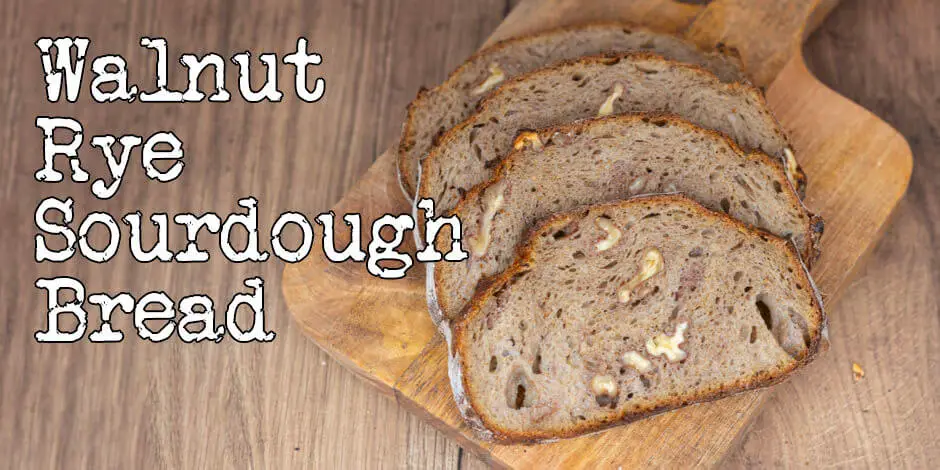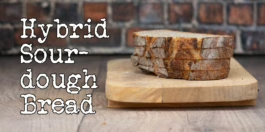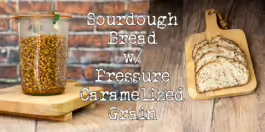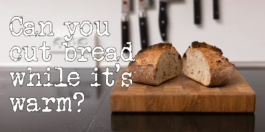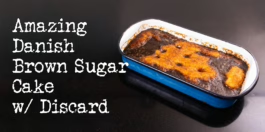When you are making a sandwich, sometimes you want a little something else. Something that compliments the toppings you want to put on the sandwich. You’ve done the white bread 100 times and it’s satisfying, no doubt. But there’s not that much taste. What should you do? This is my recipe for walnut rye sourdough bread.
This bread is inspired by two different classic Danish loaves of bread: a walnut (valnøddebrød) dark crusty bread with a soft crumb and lots of walnuts, and a Danish rye bread (rugbrød) which contains 100% rye flour and lots of seeds.
If you are just here for the recipe, you can press the button underneath to be automagically transported to the recipe:
Jump to Recipe Jump to VideoThe dough in this walnut rye sourdough recipe
Vitals
| Total weight | 1397 grams |
| Prefermented flour | 8.8% |
| Hydration | 79.4% |
| Yield | 2 small loaves of bread |
Dough
The dough consists of 70% bread flour and 30% whole-grain rye flour (dark rye). It’s important to use a high gluten bread flour, since the amount of rye in this dough, may impede the gluten development just by pure dilution. Using lots of rye is imperative to the taste though.
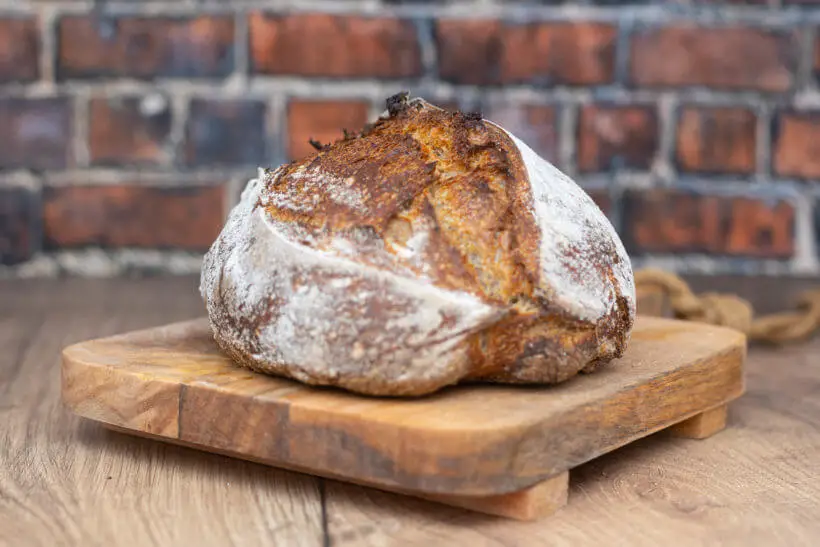
The inoculation is 20%, which should work fine in most cases. If you are somewhere warm, you may want to lower it, or if you just want to do a long and slow fermentation. The salt content is 2%, which is normal. If you are not afraid of salt, you can easily go for 2.5% for a more tasty loaf of bread.
The amount of barley malt syrup is 2.4%, which might not seem like a lot, but this is powerful stuff and will overpower the taste if you add too much.
| Weight | Ingredient | Baker's Percentage |
|---|---|---|
| 430g | bread flour | 69.4% |
| 190g | whole-grain rye flour | 30.6% |
| 480g | water | 77.4% |
| 120g | starter (100% hydration) | 19.4% |
| 12g | salt | 1.9% |
| 15g | barley malt syrup | 2.4% |
| 150g | walnuts | 24.2% |
If you want to play around with the formula, change quantity, hydration, or inoculation, you can do so here in my Bread Calculator.
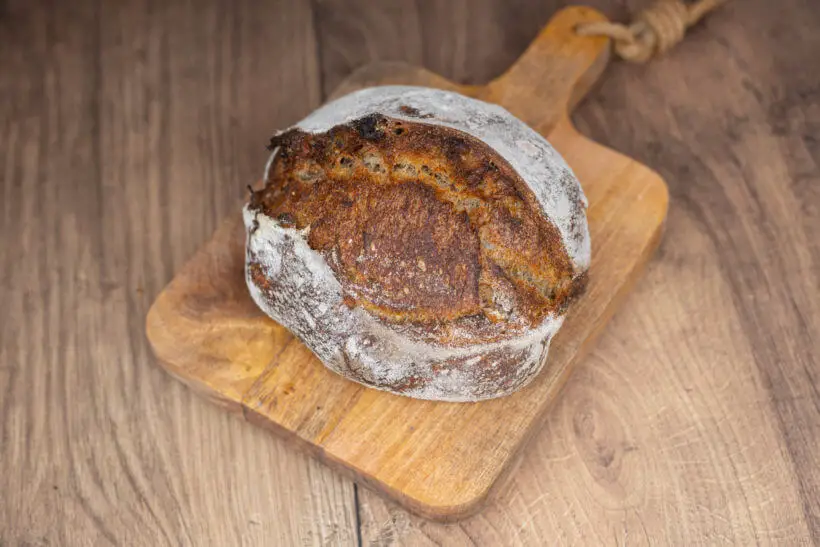
I don’t have/can’t get barley malt syrup. What I can substitute with?
If you are not able to get barley malt syrup, you can create a pretty good taste substitute.
Combine 125g/1 cup of dark ale and 125g/1 scant cup of dark brown sugar in a pot. Bring it to a boil and then let it simmer uncovered until you have a very thick syrup. This can be used in place of barley malt syrup.
Stored in the fridge, it stays good indefinitely.
The conclusion of this walnut rye sourdough bread recipe
So when this bread comes out of the oven, you cannot help but smile. The smell of the rye and barley malt syrup is unmistakable. You just want to cut into it, while it’s still warm.
When you do cut into the bread, the walnuts are scattered throughout the soft and moist crumb. When you smell it you cannot help but salivate. This is an awesome bread.
The crust is crispy, the crumb is soft. The taste is a wonderful combination of artisan sourdough bread and Danish rye bread. The delicious walnuts are just the cherry on the top.
It can be eaten with anything you’d put on Danish rye bread: butter, cheese, meats, smoked salmon, or pickled herring.
It’s wonderful Give it a try.
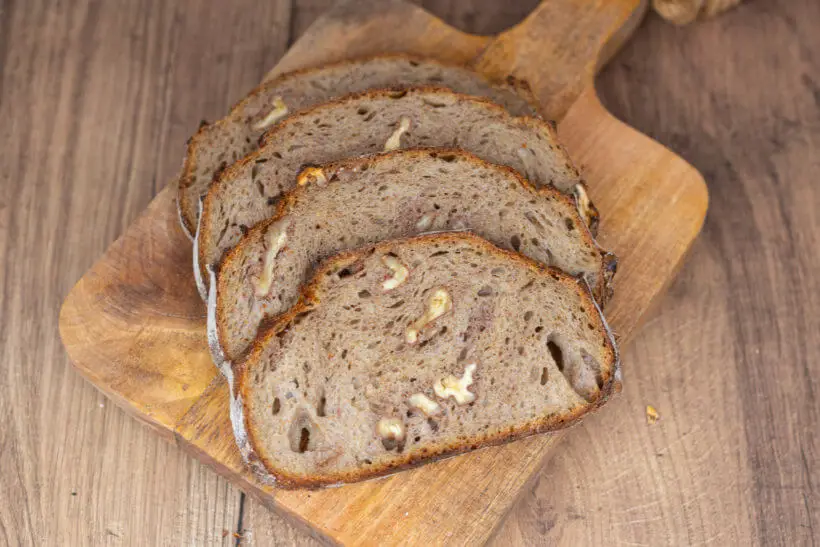
Please share this recipe for walnut rye sourdough bread
This is my recipe for walnut rye sourdough bread. If you like the recipe please consider sharing it with like-minded bread lovers on social media.
If you make it and post it on Instagram, please tag me as @foodgeek.dk so I can see it. That would make me very happy.
Ad links! The links for equipment and ingredients in this recipe are affiliate links, which means I will receive a commission if you purchase the product.
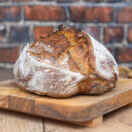
Walnut Rye Sourdough Bread
Equipment
Ingredients
- 430 g high gluten bread flour
- 190 g whole-grain rye flour
- 480 g water
- 120 g starter fed and grown to its peak
- 12 g salt
- 15 g barley malt syrup
- 150 g walnuts
Instructions
Mix the dough
- To a medium bow add: 430g bread flour, 190g rye flour and 12g salt. Mix it to distribute it evenly.
- Then add: 120g sourdough starter, 15g barley malt syrup, and 480g water.
- You may not want to add all of the water at once if your bread flour isn’t super absorbent. If you start at 416g for 70% hydration and add another 32g for 75%. The dough should not be too slack.
- Mix for a little bit. Add 150g of whole walnuts. If you like walnuts, you can use up to 300g.
- Mix until you've hydrated all flour, and let the dough rest for an hour.
Bulk fermentation
- Then do three sets of stretch and folds spaced out by 30 minutes.
- After the third set, you can check the gluten development, but it'll probably fail because of the high amount of gluten. The rest of the bulk should fix this if you've used high-gluten bread flour.
- Put the dough in a container with straight sides, and level the top of the dough.
- Then mark the top of the dough and where it will have grown 50%.
- Then put the dough somewhere warm. I use my Brød and Taylor proofer set to 30°C/86°F.
Division & Shaping
- Then when the dough has grown to 50%, divide the dough into two equally sized pieces.
- Pre-share the dough pieces into a loose ball. Let the dough rest on the counter for 20 minutes.
- The final shape of both doughs, and put them in bannetons.
- For how to shape, watch the video. I've linked the correct sized bannetons in the equipment section.
- Then put both doughs in the fridge and let them retard for at least 8 hours, but up to 48 hours.
Baking
- When it’s time to bake, heat your oven to 260°C/500°F with a dutch oven inside. I use a Challenger Bread Pan linked in the equipment section.
- After an hour of heating, grab one of the doughs from the fridge and dust the bottom with rice flour to make it slide off the peel easily.
- Flip it onto the peel and dust the top with rice flour for an exciting look. Then score the dough.
- Put the dough inside the dutch oven and the lid on the dutch oven.
- Immediately turn the heat down to 230°C/450*F and bake for 20 minutes. Then take the lid off the dutch oven and bake for another 25 minutes.
- Take it out of the oven when the bread is wonderfully browned and finished and let it cool on a wire rack.
- Reheat to 260°C/500°F and then bake the other bread the same way.



